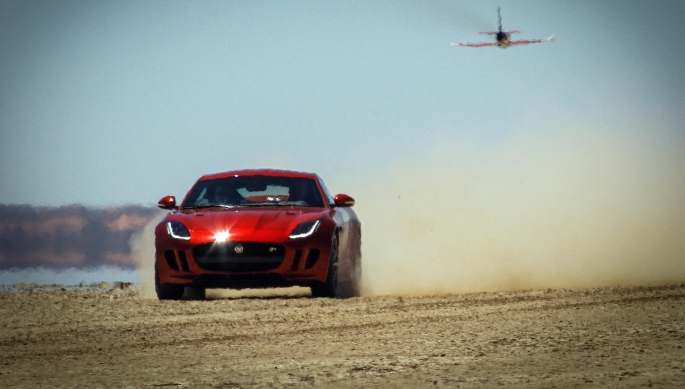
The BLOODHOUND Project today started the 12-month countdown to its first Land Speed Record attempt, and celebrated Jaguar joining the programme as Innovation Partner, by staging a high-speed communications test at Hakskeen Pan, South Africa.
An L39 jet aircraft flew multiple passes down BLOODHOUND’s specially prepared desert track, synchronised with the new All-Wheel-Drive (AWD) Jaguar F-TYPE R Coupé driven by Project Director Richard Noble and a Jaguar XF saloon, at closing speeds* of up to 700mph (1,126km/h). The cars carried the same equipment that will stream data, voice and imagery live from the BLOODHOUND Supersonic Car during test runs and record attempts in 2015 and 2016.

Above: The Jaguar F Type R AWD with Andy Green and BLOODHOUNDSSC.
A short film featuring Project Director Richard Noble, the L39 jet aircraft and the new All-Wheel-Drive (AWD) Jaguar F-TYPE R Coupé in action in South Africa at the communications test event is now available to view, share and embed at: https://www.youtube.com/user/JaguarCarsLimited.
The event was attended by representatives of the Northern Cape Government, the Project’s hosts in South Africa, and was the successful culmination of months of preparation by BLOODHOUND’s Technical Communications Partners MTN, Emcom and Poynting.
Today’s communications test saw BLOODHOUND take an important step towards fulfilling its ultimate goal: to inspire a generation about science, technology and engineering by sharing a unique engineering adventure.
To that end, data from over 300 sensors, plus three streams of 720p video, will be transmitted live via single channel from the jet and rocket powered vehicle as it blasts down the desert racetrack during the test. By way of comparison, a modern F1 car transmits 150 channels of data over a single radio channel during a Grand Prix weekend. Each run by BLOODHOUND SSC will generate information equivalent to 125 MP3 music tracks played concurrently.
Beaming data at over 1,000mph (1600km/h) will push available communications technology to the limit. To meet the challenge, MTN and Poynting Antennas have created a bespoke 4G LTE (Long-Term Evolution) network for the Project, based on known and trusted mobile telephone technology. The 800MHz signal is highly focused, rather than broadcast, to ensure the network has ‘link budget’ capable of streaming 4 Megabytes per second of data live from the car as it covers a mile in 3.6 seconds (a kilometer in 2.25 seconds).
Today the signal was captured by BLOODHOUND engineers on the track. In 2015 and 2016, it will travel to the team’s Mission Control Centre and then be relayed to the nearest town, Upington, 80 miles (130 kilometers) away, to be fed into the internet, ready to be viewed by schools, colleges and other audiences worldwide.
For this test, custom-made Poynting antennas with Sierra Wireless Air Prime embedded LTE modems were mounted on the Jaguar XF, replicating the kit which will be built in to BLOODHOUND’s tail fin. Simulated BLOODHOUND SSC data and footage from four high-resolution Stemmer Imaging cameras, equipped with unique BJR lenses, was streamed live from the Jaguar XF during the high-speed passes.
 Driving in tandem was an All-Wheel-Drive Jaguar F-TYPE R Coupé carrying Emcom’s latest Digital VHF Radio technology. This equipment has been specially calibrated to ensure clear voice communication from the Team to both Andy Green in the supersonic car and Jaguar’s two Rapid Response Vehicles. Today’s test ensured there were no frequency clashes across the spectra the team will be utilising across the 54 square mile (142 square km) area of Hakskeen Pan.
Driving in tandem was an All-Wheel-Drive Jaguar F-TYPE R Coupé carrying Emcom’s latest Digital VHF Radio technology. This equipment has been specially calibrated to ensure clear voice communication from the Team to both Andy Green in the supersonic car and Jaguar’s two Rapid Response Vehicles. Today’s test ensured there were no frequency clashes across the spectra the team will be utilising across the 54 square mile (142 square km) area of Hakskeen Pan.
Flying above the cars in the L39 Jet, BLOODHOUND’s IT manager Sarah Covell measured signal strength from the 60m tall solar powered MTN mast 9 miles (14.5 km) from the West of the track.
Today’s activity confirmed that the Project’s entire radio infrastructure is now in place, ready for 2015 and the beginning of BLOODHOUND’s high-speed campaign. It was also testament to the outstanding support and expertise of BLOODHOUND’s partners in South Africa and the UK.
– Ends –
For more information, interviews, imagery and videos contact
Jules Tipler jules.tipler@mettlepr.com / +44 (0) 7811 166 796
Notes to Editors
• The world land speed record of 763 mph is held by Thrust SSC, a UK team led by BLOODHOUND’s Project Director Richard Noble and driven by Andy Green.
• The BLOODHOUND team scoured the globe to find the perfect desert to run the car on, it needed to be at least 12 miles (19km) long, two miles (3km) wide and perfectly flat. The Hakskeen Pan, Northern Cape, South Africa was selected.
• At full speed BLOODHOUND SSC will cover a mile (1.6km) in 3.6 seconds, that’s 4.5 football pitches laid end to end per second.
• BLOODHOUND has three power plants, a Rolls-Royce EJ200 jet from a Eurofighter Typhoon, a cluster of Nammo hybrid rockets and a 650 bhp engine that drives the rocket oxidiser pump. Between them they generate 135,000 thrust hp, equivalent to 180 F1 cars.
• BLOODHOUND SSC is currently being assembled at the BLOODHOUND Technical Centre in Bristol, UK. It is on schedule for roll out summer 2015 where it will undergo UK runway testing up to 200 mph (321 km/h) at the Aerohub, Newquay. The Team will then deploy to South Africa to begin high speed testing with the target of reaching 800 mph (1,287 km/h). The Team will return to the UK to review the data and return to South Africa in 2016 with the aim of reaching 1,000 mph (1,609 km/h)
• Over 250 global companies, 180 of them SMEs, are involved in the Project, which has become a showcase for science and engineering capability.
• Over 5,700 UK primary and secondary schools have signed up to use the free BLOODHOUND Education resources in their classrooms
• The educational outreach programme also runs in South Africa with more than 600 schools already participating and more than 100 BLOODHOUND Ambassadors signed up to help use the project to inspire young people about studying maths and science. The programme reaches out to schools across the country, but particularly in the Northern Cape Province, home to the track where the BLOODHOUND SSC will run.
• *Closing speed is total speed of two objects as they head towards one another








